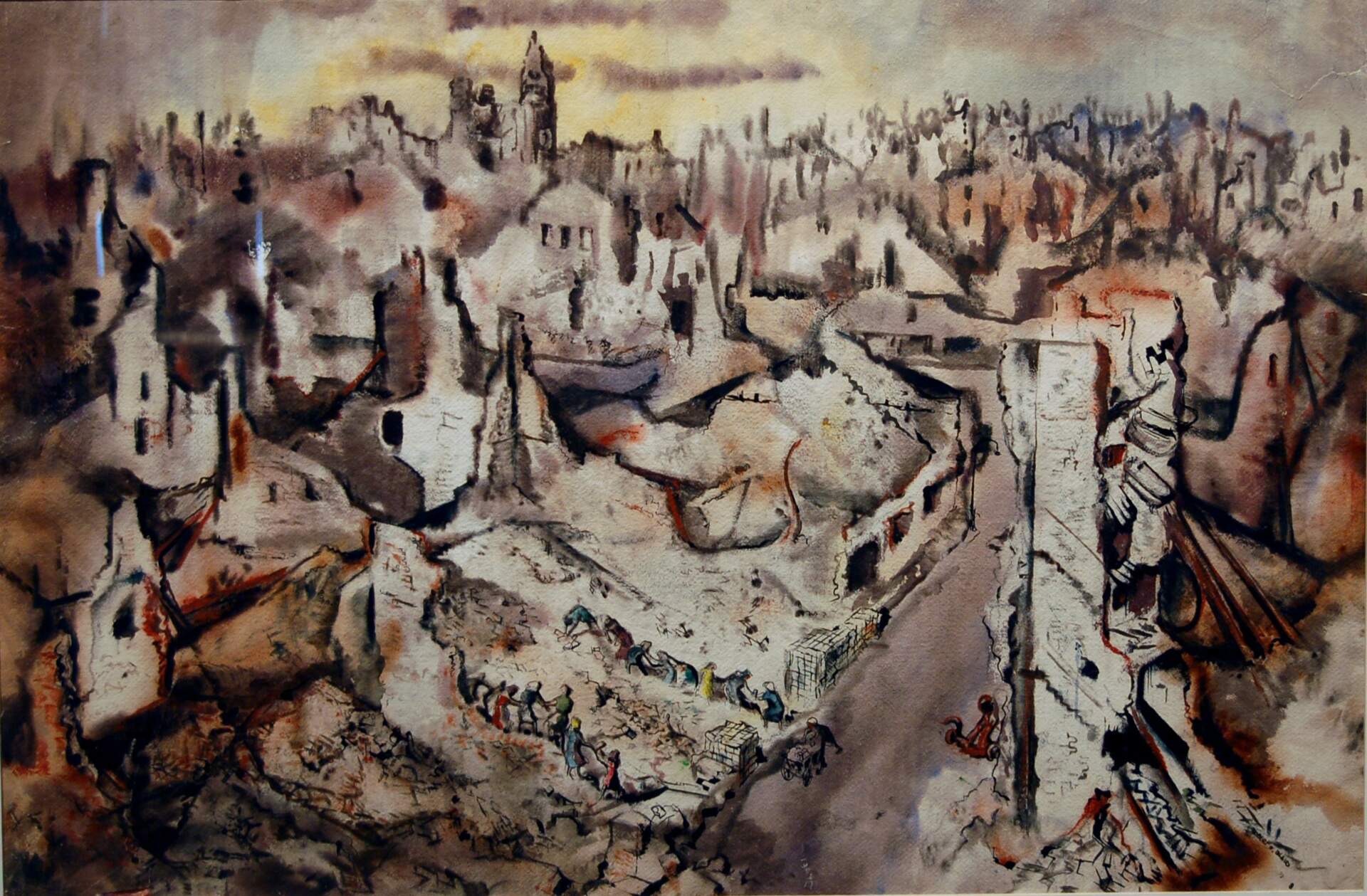
Robert N. Blair (1912-2003), Berlin Ruin - Downtown Section with Women Stacking Rubble, Berlin, 1945, watercolor on paper, 27 x 40 inches, Burchfield Penney Art Center, Gift of the artist, 1985
Robert N. Blair: A Soldier's Portfolio
Past
Aug 25, 1985 - Sep 22, 1985
A SOLDIER'S PORTFOLIO
By Nancy Weekly
Since the time of the ancient Egyptians, war has been a subject for artists. For approximately 5,000 years, war art glorified victors in images dictated by contemporary aesthetic standards. Artists, who more often than not were absent from actual combat, were expected to create legendary war scenes in which prominent individuals would be exalted for posterity. These imaginary images of war remain our historical heritage.
It wasn't until the 19th century, with the emergence of photography as a means of documentation during the Crimean War in southeast Europe and the Civil War in the United States, that artists were encouraged to reveal more realistic images of war. This doesn't mean, of course, that romanticized paintings of war ceased to exist. Even during both the World Wars artists in England, for example, were employed by the Ministry of Information and branches of the armed forces to create artistic propaganda subject to approval before being shown. Nevertheless, there has gradually arisen an increasing presence of the artist's personal feelings toward war in works that expose a greater fidelity to reality.
Robert N. Blair, as an enlisted soldier in the paratroop glider division of the U. S. Army, was not able to suppress his identity as an artist when he put on his uniform. The itinerant artist sketched and painted whenever an opportunity arose. Before going overseas he painted murals in the Alabama boot camp. At first he was discouraged from making spontaneous works, but the objecting officer was soon over ruled by General Liebel who granted Blair permission to carry his art supplies anywhere as long as it didn't interfere with his duties as a soldier.
Only a portion of the paintings and drawings that Blair produced in Europe during World War II have been selected for this exhibition. Generally his small works were executed in situ and the large watercolors were created back at camp. The essence of a scene is captured in the quick drawings and watercolors with a fluidity of line and an immediacy of gesture that makes them particularly appealing. Later enlarged compositions are more detailed, being derived from preliminary sketches and influenced by the impact of an accumulation of impressions. It is possible that Blair's paintings of the Battle of the Bulge are the only genuine firsthand accounts of Allied troops countering the German assault in Belgium in January 1945. A few works, painted more recently, are a combination of images that reemerge in memory and compositional notes from the field. Blair says that "painting under stress had, for me, beneficial results. Working in the dark became a normal procedure - as was drawing and painting on moving vehicles - also, I liked having moving subjects."
Among the works there are quiet moments when Blair was able to document in Britain the preparations made to reach the mainland. The watercolors from France, painted for the most part with a brighter palette, show less of the appearance of war than the dark, stygian visions of destruction in Germany. In the latter hellish scenes of Berlin, refugees cart their parcels among the ruins, but they seem incapable of escaping.
The largest number of works are those from the Battle of the Bulge where U.S. troops suffered extremely heavy causalities. An almost incongruous contrast exists between the snow-covered landscape and the military action. Struck by this dichotomy Blair says, "The Ardennes hill country and forest in Belgium looked a lot like paintings of Pieter Breugel. The areas that weren't torn up by the battle were often beautiful, making the killing seem worse." Blair's watercolor approach is direct, yet lyrical. His visual chronicle reveals with great sensitivity his concern for humanity and his works illustrate the toll taken on both sides when war is waged.
There are many painful recollections for Blair. As works were selected from a voluminous number stored in his studio, Blair recounted his experiences. It became clear that these paintings each triggered profound memories — and through his art Blair is dedicated to trying to re late his attitudes about the desolation of war.
Finally one can say that Blair's art from World War II documents, but also interprets what took place in Europe. One absorbs from it a series of emotions, as one imagines they were encountered by a soldier: fear, bewilderment, horror, dismay. The works draw the viewer into them with an almost hypnotic force. This is a moving experience, but not an intimidating one with Blair as our mediator.